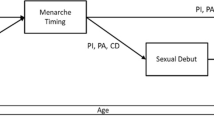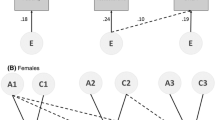Abstract
We propose and explore a twin model to examine the basis for synchrony that often characterizes different facets of normal development. In so doing we also present an approach to the analysis of “soft” events; events for which available reports of dates or ages of occurrence are unreliable or inconsistent. Discrepancies among reports are accounted for by a statistical measurement model. This combines current status error reflecting uncertain definition of onset and two mechanisms for the phenomenon of “telescoping,” namely, systematic compression of the time scale and heteroscedastic random measurement error. Statistically, the model can be viewed as a mixed generalized linear model with random effects within both mean and variance functions or, alternatively, as involving multiplicative random effects. We apply the model to multiple maternal reports on menarche and onset of breast development in twin daughters. Fitted to data from the Virginia Twin Study Of Adolescent and Behavioral Development by the use of penalized/predictive quasi-likelihood, the model provided much improved estimates of the true age-at-onset distribution as compared to those from a naive analysis. Results suggested that the observed variance was made up almost entirely of genetic variance and measurement error variance due to telescoping and current status errors and that the timing of breast development and menarche are largely under the control of a common set of genes. Results also indicated that maternal recollections of the onset of breast development were both more poorly defined and subject to greater recall errors than maternal recollections of menarche.
Similar content being viewed by others
REFERENCES
Aitkin, M. (1987). Modelling variance heterogeneity in normal regression using GLIM. Appl. Stat. 36:332–339.
Alsaker, F. D. (1996). The impact of puberty. J. Child Psychol. Psychiatry 37:249–258.
Bollen, K. A. (1995). Structural equation models that are non-linear in latent variables: A least squares estimator. Sociol. Method. 25:223–251.
Boomsma, D. I., Molenaar, P. C. M., and Orlebeke, J. F. (1990). Estimation of individual genetic and environmental factor scores. Genet. Epidemiol. 7:83–91.
Bradburn, N., Huttenlocher, J., and Hedges, L. (1994). Telescoping and temporal memory. In Schwarz, N., and Sudman, F. (eds.), Autobiographical Memory & the Validity of Retrospective Recall, Springer-Verlag, New York, pp. 203–215.
Breslow, N. E., and Clayton, D. G. (1993). Approximate inference in generalized linear mixed models. J. Am. Stat. Assoc. 88:9–25.
Breslow, N. E., and Lin, X. (1995). Bias correction in generalized linear mixed models, with a single component of dispersion. Biometrica 82:81–92.
Caspi, A., and Moffitt, T. E. (1991). Individual differences are accentuated during periods of social change: The sample case of girls at puberty. J. Person. Soc. Psychol. 61:157–168.
Cox, D. R., and Oakes, D. (1984). Analysis of Survival Data, Chapman & Hall, London.
Diamond, I. D., and McDonald, J. W. (1992). Analysis of current status data. In Trussell, J. W., Hankinson, R., and Tilton, J. (eds.), Demographic Applications of Event History Analysis, Clarendon Press, Oxford, pp. 231–252.
Diggle, P. J., Liang, K.-Y., and Zeger, S. L. (1994). Analysis of Longitudinal Data, Oxford Science, Oxford.
Eaton, W. W., Kramer, M., Anthony, J. C., Dryman, A., Shapiro, S., and Locke, B. Z. (1989). The incidence of specific DIS/DSM-III mental disorders: Data from the NIMH Epidemiologic Catchment Area Program. Acta Psychiatry Scand. 79:163–178.
Goldstein, H. (1991). Nonlinear multilevel models with an application to discrete response data. Biometrika 78:45–51.
Goldstein, H. (1995). Multilevel Statistical Models, 2nd ed., Edward Arnold, London.
Hobcraft, J., and Murphy, M. (1987). Demographic event history analysis: A selective review. In Crouchley, R. (ed.), Longitudinal Data Analysis, Avebury, Aldershot.
Holt, D., McDonald, J. W. and Skinner, C. J. (1991). The effect of measurement error on event history analysis. In Biemer, P. B., Groves, R. M., Lyberg, L. E., Mathiowetz, N. A., and Sudman, S. (eds.), Measurement Errors in Surveys, Wiley, New York.
Huttenlocher, J., Hedges, L., and Prohaska, V. (1988). Hierarchical organisation in ordered domains: Estimating dates of events. Psychol. Rev. 95:471–484.
Kannisto, V., Lauritsen, J., Thatcher, A. R., and Vaupel, J. W. (1994). Reductions in mortality at advanced ages: Several decades of evidence from 27 countries. Popul. Dev. Rev. 20:793–810.
Magnusson, D., Stattin, H., and Allen, V. L. (1986). Differential maturation among girls and its relations to social development: A longitudinal perspective. In Baltes, P. B., Featherman, D. L., and Lerner, R. M. (eds.), Life-Span Development and Behavior, Vol. 7, Erlbaum, Hillsdale, NJ, pp. 113–134.
Molenaar, P. C. M., Boomsma, D. I., Neeleman, D., and Dolan, C. V. (1990). Using factor scores to detect G × E interactive origin of “pure” genetic or environmental factors obtained in genetic covariance structure analysis. Genet. Epidemiol. 7:93–100.
Muthen, B. (1984). A general structural equation model with dichotomous, ordered categorical and continuous latent variable indicators. Psychometrika 49:115–132.
Muthen, B., and Satorra, A. (1989). Multilevel aspects of varying parameters in structural models. In Bock, R. D. (ed.), Multilevel Analysis of Educational Data, Academic Press, San Diego, CA.
Neale, M. C. (1994). Statistical Modelling with Mx, Department of Psychology, Medical College of Virginia, Richmond.
Neale, M. C., and Cardon, L. R. (1992). Methodology for Genetic Studies of Twins and Families, Kluwer, Dordrecht.
Neale, M. C., Eaves, L. J., Hewitt, J. K., MacLean, C. J., Meyer, J. M., and Kendler, K. S. (1989). Analyzing the relationship between age of onset and risk to relatives. American. J. Hum. Genet. 45:226–239.
Nelder, J. A. (1992). Joint modelling of mean and dispersion. In van der Heijden, P. G. M., Jansen, W., Francis, B., and Seeber, G. U. H. (eds.), Statistical Modelling, Elsevier Science, New York, pp. 263–272.
Nelder, J. A., and Wedderburn, R. W. M. (1972). Generalized linear models. J. Roy. Stat. Soc. A 135:370–384.
Pickles A., Crouchley, R., Simonoff, E., Eaves, L., Meyer, J., Rutter, M., Hewitt, J., and Silberg, J. (1994a). Survival models for developmental genetic data: Age of onset of puberty and antisocial behaviour in twins. Genet. Epidemiol. 11:155–170.
Pickles, A., Neale, M., Simonoff, E., Rutter, M., Hewitt, J., Meyer, J., Crouchley, R., Silberg, J., and Eaves, L. (1994b). A simple method for censored age of onset data subject to recall bias: Mother's reports of age of puberty in male twins. Behav. Genet. 24:457–468.
Pickles, A., Pickering, K., and Taylor, C. (1996). Reconciling recalled dates of developmental milestones, events and transitions: A mixed generalized linear model with random mean and variance functions. J. Roy. Stat. Soc. 159A:225–234.
Pickering, K., Pickles, A., Taylor, C., and Yang, S. (1998). Age of onset of smoking (submitted for publication).
Rasbash, J., Woodhouse, G., Yang, M., and Goldstein, H. (1995). MLn: Command Reference Guide, Institute of Education, London.
Rodriguez, G., and Goldman, N. (1995). An assessment of estimation procedures for multilevel models with binary responses. J. Roy. Stat. Soc. 158:73–90.
Rubin, D., and Baddeley, A. (1989). Telescoping is not time compression: A model of the dating of autobiographical events. Memory Cognit. 17:653–661.
Simon, G. E., and VonKorff, M. (1995). Recall of psychiatric history in cross-sectional surveys: Implications for epidemiologic research. Epidemiol. Res. 17:221–227.
Simonoff, E., Pickles, A., Hewitt, J., Rutter, M., Silberg, J., Eaves, L., and Meyer, J. (1995). Incorporating information from multiple raters of child behavior using a genetic strategy to examine shared views and bias. Behav. Genet. 25:311–326.
Skowronski, J. J., Betz, A. L., Thompson, C. P., Walker, W. R., and Shannon, L. (1994). The impact of differing memory domains on event dating processes in self and proxy reports. In Schwarz, N., and Sudman, F. (eds.), Autobiographical Memory & the Validity of Retrospective Recall, Springer-Verlag, New York, pp. 217–231.
Spearman, C. (1904). General intelligence objectively determined and measured. Am. J. Psychol. 15:201–293.
Sudman, S., and Bradburn, N. M. (1973). Effects of time and memory factors on response in surveys. J. Am. Stat. Assoc. 63:805–815.
Thompson, R., and Baker, R. J. (1981). Composite link functions in generalised linear models. Appl. Stat. 30:125–131.
Author information
Authors and Affiliations
Rights and permissions
About this article
Cite this article
Pickles, A., Pickering, K., Simonoff, E. et al. Genetic “Clocks” and “Soft” Events: A Twin Model for Pubertal Development and Other Recalled Sequences of Developmental Milestones, Transitions, or Ages at Onset. Behav Genet 28, 243–253 (1998). https://doi.org/10.1023/A:1021615228995
Issue Date:
DOI: https://doi.org/10.1023/A:1021615228995




